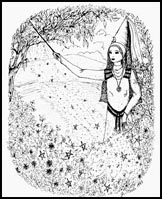MAGICAL PLANTS
by Joelle Steele

Lonely? Short of cash? Feeling unwell? Perhaps you should consider taking advantage of the "magical" powers of your houseplants! Witches have been doing it since the dawn of time. In addition to using plants to cast their spells, they use them to adorn their magic circles, the areas of protective power in which they perform their rituals.
MAGICAL DAYS
Each year there are eight witches' days of power, or Sabbats, many of which survive in our modern times as May Day, Halloween, Christmas, and even Ground-hog Day. Celebrants of Samhain (Halloween) adorn their magic circles with pumpkins, pomegranates, apples, hazel, and thistle. Yule, the Sabbat of the Winter Solstice, has been considered a time of divine  births since the 4th century BC. Since then, witches have
births since the 4th century BC. Since then, witches have
Illustration by Joelle Steele
adorned their homes and their magic circles with all the trappings that Christians later adopted in 273 AD, the year of the first official observation of the birth of Jesus Christ at the time of the Winter Solstice. Yule plants include holly, ivy, mistletoe, bay, juniper, pine, nutmeg, and, of course, a decorated tree.
PLANT SPELLS
Many plants, herbs, and flowers are also used in magic rituals and spells. For example, in a money-attracting spell, witches use herbs or oils of herbs such as orange bergamot, honeysuckle, mint, patchouly, pine, or vervain. To instill peace and harmony, gardenia, lavender, meadowsweet, morning glory, myrtle, passion flower, pennyroyal, or violet are used. Healing is promoted with the use of angelica, carnation, eucalyptus, gardenia, ivy, mugwort, myrrh, rosemary, sandalwood, or Ti plants. And don't forget attracting love; there are more than enough suitable plants for that purpose. Among them are aster, lemon balm, basil, betony, catnip, columbine, daffodil, geranium, hibiscus, jasmine, juniper, lemon verbena, lobelia, maidenhair, marjoram, myrtle, pansy, peppermint, periwinkle, plumeria, rose, rosemary, rue, thyme, willow, and yarrow.
MAGICAL PLANT NAMES
Some plants have been used in magic for so long that their common names reflect their ancient usages:
Wax plants (Hoya carnosa) used to be called "pentagram plants" after the shape of their flowers which form the pentagram, or five-pointed star, the magical symbol of protection. Hoyas are grown indoors for protection and are even dried and kept to be worn as amulets. They are also used in magic rituals to increase the witch's spell-casting ability.
Vervain (Verbena officinalis) was once known as the "enchanter's plant." The priests of the god Jupiter in ancient Rome used it to clean their altars. It was also used at that time to bind a spell, to make it work on the person for whom it was intended. Today it is used in love potions and protective spells and may be worn as an amulet. Grown indoors it is used to protect homes from lightning and storms.
The Ti plant (Dracaena cordyline terminalis) is known in Hawaiian folklore as the "good luck plant." The leaves were once carried on ships to ward off storms and were worn by travelers as protection from drowning at sea. Today, when the green variety is planted around a house it protects the structure.
Passion flowers (Passiflora incarnata) do not live up to their common name when it comes to magical uses. Instead of encouraging passion, they are grown indoors to create peace and harmony and can be carried as an amulet to attract friends.
Carnations (Dianthus carophyllus) were once called "scaffold flowers" because they were worn during the Elizabethan era as protection from being hanged. Today, they are used in casting protective and healing spells.
Alyssum was once known as "madwort" because in olden days it was believed to cure hydrophobia (rabies). It was also once worn as an amulet and hung in houses to protect from the evil eye. Today, it is used to calm an angry person if it is touched to their hand or body.
Other "magical" plants which have been in use since ancient times:
Ivy (Hedera species) was used in the worship of Bacchus, the god of wine and revelry. Its magical uses included luck when worn by women — brides in particular. Today, if made into an amulet or charm, it is said to promote love and fidelity.
Red geraniums (Pelargonium species) were once believed to move in such a way that they warned a witch of the approach of strangers. They are still used today for protection and to strengthen health. Pink-flowered geraniums are used to attract love, and white-flowered varieties are used to increase fertility.
Gardenias with their fragrant blossoms, have always been used by witches in spells that attract love, or that bring good spirits forth during magic rituals. They are also now used to promote healing and to create peace and harmony in a room.
Ferns of any kind have very old magical uses, some of which endure to this day. For example, the modern practice of florists including fern fronds in their bouquets of roses or other flowers, originated as a gift of protection to the recipient. Drinking fern sap was once said to make you eternally young, and these plants are still used in money-attracting rituals.
The Norfolk Island Pine (Auricaria excelsa), in a form very similar to that of its ancestors, has been around since prehistoric times. When grown in or around the home, it offers protection from hunger and evil spirits.

